Creative Market-Rate Development Without Displacement
by Housing Forward-MA Staff
The Massachusetts housing crisis has become such a large-scale issue it is understandable that proposed solutions often focus on those that are equally large. While people typically picture cranes and large apartment buildings when they think of housing growth, increased density can take many forms. Smaller-scale, creative tweaks to how we design, build, permit, and think about new housing, when repeated over and over again, can have equally impactful results for addressing both Massachusetts’ overall housing shortage and the lack of missing middle housing.
Several current projects in Boston, supported by the city’s Compact Living Pilot Program, provide examples of how allowing new buildings to better respond to residents’ varying needs for space, rethinking outdated assumptions about personal car-ownership, and opening up vacant or commercial land for residential use can help create new, well-designed housing that is naturally affordable to middle-income residents. Boston’s pilot program allows for smaller units with creative floor plans, no required parking, and a focus on shared amenities and transportation, allowing more homes to be built in the same amount of space. This, in turn, keeps project budgets low, giving small, local builders the opportunity to participate in the housing economy and charge rents that are affordable for middle-income tenants. Further, allowing this new construction on vacant lots, parking lots, or areas previously zoned only for commercial uses reduces the displacement of existing residents.The Boston Globe recently profiled two examples of these projects in Dorchester: a 4-story, 14 studio building that, upon completion, will rent for $650 or $850 a month; and a 29-unit, mostly studio building that will rent for around $1,250 a month. For comparison, even with a decrease in rents due to the pandemic, the median rent for a studio apartment in Boston in April 2021 was $1,750. For these two projects, the slight increase in allowed density translated into a market-rate rent at least 29% below the median - a savings to tenants of $500 or more per month.
These creative housing solutions that support smaller scale, market-rate development are creating the missing middle housing that our communities need. Zoning that allows more units on a single lot, design flexibility, decreased parking minimums, and accessory dwelling units can play an important role in solving the affordability crisis. We hope to see more neighborhoods and communities embrace these tools, creating opportunities for homes of all shapes and sizes across the Commonwealth.
